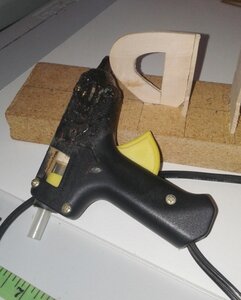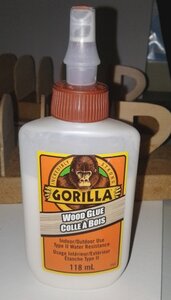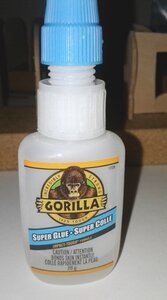- Joined
- Feb 18, 2019
- Messages
- 685
- Points
- 353

Here is an overview of the glue used through the construction of the canoe.
Note: this is what I personally use. This is not a recommendation as to what needs to be used.
The choice is mainly based on drying time, which can be important in some of the construction steps.
Gluing the station mold...
Hot glue: care must be taken to apply only a thin film to the area to be glued. For that use a small size "gun" with appropriate sticks. This is quick, squaring the mold is not a problem, everything solidly stays in place.
Easy to remove from the building base to build anther model.

All other building steps can be achieve with any type wood glue. Again, application should be a thin run on one of the contact areas to be joined.
Here is the glue I use. This is basically yellow carpenter's glue. It sets fairly quickly under tight hold or clamping and creates a thin joint line. It may penetrate the wood so careful application is needed: glue marks may show after application of finishes.

Installation of the ribs
Here's what I use:
Reason: very quick drying. works well with strips soaked in water for all curved areas (excess water should be wiped off the strip before glue application), and here again, only use as much glue as needed: avoid excess...

As mentioned at the top of this post, glue kind / brand is a matter of personal choice.
In regards to longevity, I have seen some of the canoes I have built in the past 20 years and they are still intact. The brand may have been different at some point but the results have been the same.
I have also experimented with building complete models using either wood glue or instant glues on their own (different brands from what is shown here). Either way, it will work: wood glue will only be much slower as some areas are hard to hold in place either than holding / pressing down by hand (especially the ribs as they are curved), and that is where instant glues are most useful.
I do understand about toxicity in the instant stuff ...... so I also recognize that not everyone would use that stuff.
G.
Note: this is what I personally use. This is not a recommendation as to what needs to be used.
The choice is mainly based on drying time, which can be important in some of the construction steps.
Gluing the station mold...
Hot glue: care must be taken to apply only a thin film to the area to be glued. For that use a small size "gun" with appropriate sticks. This is quick, squaring the mold is not a problem, everything solidly stays in place.
Easy to remove from the building base to build anther model.

All other building steps can be achieve with any type wood glue. Again, application should be a thin run on one of the contact areas to be joined.
Here is the glue I use. This is basically yellow carpenter's glue. It sets fairly quickly under tight hold or clamping and creates a thin joint line. It may penetrate the wood so careful application is needed: glue marks may show after application of finishes.

Installation of the ribs
Here's what I use:
Reason: very quick drying. works well with strips soaked in water for all curved areas (excess water should be wiped off the strip before glue application), and here again, only use as much glue as needed: avoid excess...

As mentioned at the top of this post, glue kind / brand is a matter of personal choice.
In regards to longevity, I have seen some of the canoes I have built in the past 20 years and they are still intact. The brand may have been different at some point but the results have been the same.
I have also experimented with building complete models using either wood glue or instant glues on their own (different brands from what is shown here). Either way, it will work: wood glue will only be much slower as some areas are hard to hold in place either than holding / pressing down by hand (especially the ribs as they are curved), and that is where instant glues are most useful.
I do understand about toxicity in the instant stuff ...... so I also recognize that not everyone would use that stuff.
G.

